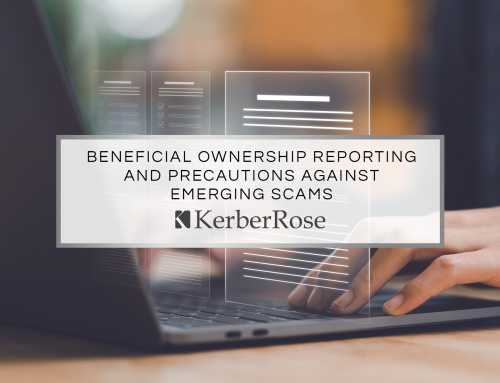Financial Stress Tests: Ensure the Survival of Your Non-Profit Organization
While almost every industry feels the effects of inflation, it hits non-profits especially hard. Rising inflation means potential donors have fewer funds to allocate to charitable causes. Consequently, many non-profit organizations have seen a sharp decrease in donations and related revenue sources, in addition to rising costs. In this environment, it’s more important than ever for non-profits to think and act strategically.
One way non-profit organizations can begin to act strategically is to evaluate their current and future financial situation by employing a financial stress test. Financial stress tests will not only show how resistant an organization is in the face of hardships but also reveals previously hidden weaknesses. These insights will guide a non-profit organization to make changes and strategic shifts, which can help ensure survival.
What is a financial stress test, exactly?
A financial stress test is an analysis or simulation used to determine how well an organization can weather various financial hardships. This test is a tool used by many organizations to project the effects of an array of situations. Organizations propose scenarios and analyze specific metrics to understand their strengths and weaknesses. In this manner, organizations can determine whether or not strategic changes are needed to ensure continued success.
What scenarios should non-profits consider?
A stress test is only as effective as the relevance of the scenarios upon which it is based. As such, stress test scenarios need to be tailored to the specific environment, industry and organization in question. While every industry and organization has unique circumstances and concerns, non-profits are distinctive, as their revenue streams depend upon donations and grants rather than output. This means leaders of non-profits need to ask a set of very specific questions about their environment to identify key weaknesses to target for improvement. By asking and addressing the following questions and concerns in advance, your non-profit will be in a better position to withstand financial difficulties:
- What if donations drop by a considerable percentage due to inflation or other economic hardships?
Moreso than any other industry, non-profits rely upon donations as an income source. This situation makes non-profits more susceptible to the effects and stresses of general economic downturns. Consequently, non-profits should develop and regularly update a plan for withstanding difficult financial times.
- What if a large donor or grant is eliminated?
Non-profits need to ensure they don’t rely too heavily on a singular donor or grant, because losing this funding source could be catastrophic for the organization’s future. Non-profits should ensure they have a variety of diverse funding sources and a plan to compensate for the loss of a significant donor or grant.
- What if funding priorities change/shift?
Currently, the political and social priorities of the world shift very quickly. For mission-based non-profits, this can be both a good and a bad thing; a mission which receives a lot of recognition and favor today could experience a downturn tomorrow, and vice versa. Even the most well-funded non-profits need to strategize for a future in which funding could significantly decrease.
- What if expenses increase?
Inflation can also lead to increases in employee salaries and other operating expenses. Non-profits need to analyze their operating budget and income sources to determine how to strategically accommodate and offset spikes in such expenses.
The questions above are only some of the most common questions non-profit leaders should routinely ask. Successful tests will identify weaknesses and develop a contingency plan for each worst-case scenario. Every organization needs to have an in-depth understanding of the particular stressors and environment in which it operates. This understanding guides the development of specific questions and scenarios for an effective financial stress test.
What metrics should be monitored?
In addition to asking questions about future scenarios, non-profits should also regularly monitor a few key metrics. Routinely monitoring key metrics ensures your non-profit organization is proactive in identifying and addressing weaknesses before they become a bigger problem. As such, your non-profit is in a better position to withstand financial difficulties before they become a financial crisis.
Categories of key metrics every non-profit organization should regularly review and analyze include:
- Liquidity
Liquidity refers to the amount of cash an organization has readily available to cover daily operating expenses. Liquidity is important because it ensures activities can continue uninterrupted during difficult times. Metrics and considerations which indicate liquidity include:
-
- Current Ratio (total current assets / total current liabilities)
- Cash Reserve: Covering at Least 90 days of Expenses
- Line of Credit Amount
- How much of the accounts payable is over 90 days?
- How much of the accounts receivable is over 90 days?
- Sustainability
A key feature of sustainability is ensuring revenues are reliable and consistent. Sustainability is typically more tenuous for non-profits than for-profit organizations, as non-profits rely on donations and grants. Accordingly, it’s important for non-profit leaders to regularly evaluate whether they have the financial strength to continue operating into the foreseeable future. Metrics and considerations which help evaluate sustainability include:
-
- Does the organization have at least 25% operating reserves?
- Is the organization’s revenue highly concentrated with a few donors or grants?
- Are there ongoing legal issues?
- Are there any outstanding tax issues?
There are many other scenarios and critical metrics to consider when determining whether or not your non-profit can weather difficult economic times. Remember, a financial stress test is only as powerful and relevant as the questions and scenarios it addresses. Thus, it’s crucial to ensure you ask the right questions and analyze the right metrics. Contact one of our KerberRose Trusted Advisors to help ensure you are securing the survival of your non-profit organization.
Financial Stress Tests: Ensure the Survival of Your Non-Profit Organization
While almost every industry feels the effects of inflation, it hits non-profits especially hard. Rising inflation means potential donors have fewer funds to allocate to charitable causes. Consequently, many non-profit organizations have seen a sharp decrease in donations and related revenue sources, in addition to rising costs. In this environment, it’s more important than ever for non-profits to think and act strategically.
One way non-profit organizations can begin to act strategically is to evaluate their current and future financial situation by employing a financial stress test. Financial stress tests will not only show how resistant an organization is in the face of hardships but also reveals previously hidden weaknesses. These insights will guide a non-profit organization to make changes and strategic shifts, which can help ensure survival.
What is a financial stress test, exactly?
A financial stress test is an analysis or simulation used to determine how well an organization can weather various financial hardships. This test is a tool used by many organizations to project the effects of an array of situations. Organizations propose scenarios and analyze specific metrics to understand their strengths and weaknesses. In this manner, organizations can determine whether or not strategic changes are needed to ensure continued success.
What scenarios should non-profits consider?
A stress test is only as effective as the relevance of the scenarios upon which it is based. As such, stress test scenarios need to be tailored to the specific environment, industry and organization in question. While every industry and organization has unique circumstances and concerns, non-profits are distinctive, as their revenue streams depend upon donations and grants rather than output. This means leaders of non-profits need to ask a set of very specific questions about their environment to identify key weaknesses to target for improvement. By asking and addressing the following questions and concerns in advance, your non-profit will be in a better position to withstand financial difficulties:
- What if donations drop by a considerable percentage due to inflation or other economic hardships?
Moreso than any other industry, non-profits rely upon donations as an income source. This situation makes non-profits more susceptible to the effects and stresses of general economic downturns. Consequently, non-profits should develop and regularly update a plan for withstanding difficult financial times.
- What if a large donor or grant is eliminated?
Non-profits need to ensure they don’t rely too heavily on a singular donor or grant, because losing this funding source could be catastrophic for the organization’s future. Non-profits should ensure they have a variety of diverse funding sources and a plan to compensate for the loss of a significant donor or grant.
- What if funding priorities change/shift?
Currently, the political and social priorities of the world shift very quickly. For mission-based non-profits, this can be both a good and a bad thing; a mission which receives a lot of recognition and favor today could experience a downturn tomorrow, and vice versa. Even the most well-funded non-profits need to strategize for a future in which funding could significantly decrease.
- What if expenses increase?
Inflation can also lead to increases in employee salaries and other operating expenses. Non-profits need to analyze their operating budget and income sources to determine how to strategically accommodate and offset spikes in such expenses.
The questions above are only some of the most common questions non-profit leaders should routinely ask. Successful tests will identify weaknesses and develop a contingency plan for each worst-case scenario. Every organization needs to have an in-depth understanding of the particular stressors and environment in which it operates. This understanding guides the development of specific questions and scenarios for an effective financial stress test.
What metrics should be monitored?
In addition to asking questions about future scenarios, non-profits should also regularly monitor a few key metrics. Routinely monitoring key metrics ensures your non-profit organization is proactive in identifying and addressing weaknesses before they become a bigger problem. As such, your non-profit is in a better position to withstand financial difficulties before they become a financial crisis.
Categories of key metrics every non-profit organization should regularly review and analyze include:
- Liquidity
Liquidity refers to the amount of cash an organization has readily available to cover daily operating expenses. Liquidity is important because it ensures activities can continue uninterrupted during difficult times. Metrics and considerations which indicate liquidity include:
-
- Current Ratio (total current assets / total current liabilities)
- Cash Reserve: Covering at Least 90 days of Expenses
- Line of Credit Amount
- How much of the accounts payable is over 90 days?
- How much of the accounts receivable is over 90 days?
- Sustainability
A key feature of sustainability is ensuring revenues are reliable and consistent. Sustainability is typically more tenuous for non-profits than for-profit organizations, as non-profits rely on donations and grants. Accordingly, it’s important for non-profit leaders to regularly evaluate whether they have the financial strength to continue operating into the foreseeable future. Metrics and considerations which help evaluate sustainability include:
-
- Does the organization have at least 25% operating reserves?
- Is the organization’s revenue highly concentrated with a few donors or grants?
- Are there ongoing legal issues?
- Are there any outstanding tax issues?
There are many other scenarios and critical metrics to consider when determining whether or not your non-profit can weather difficult economic times. Remember, a financial stress test is only as powerful and relevant as the questions and scenarios it addresses. Thus, it’s crucial to ensure you ask the right questions and analyze the right metrics. Contact one of our KerberRose Trusted Advisors to help ensure you are securing the survival of your non-profit organization.
Financial Stress Tests: Ensure the Survival of Your Non-Profit Organization
While almost every industry feels the effects of inflation, it hits non-profits especially hard. Rising inflation means potential donors have fewer funds to allocate to charitable causes. Consequently, many non-profit organizations have seen a sharp decrease in donations and related revenue sources, in addition to rising costs. In this environment, it’s more important than ever for non-profits to think and act strategically.
One way non-profit organizations can begin to act strategically is to evaluate their current and future financial situation by employing a financial stress test. Financial stress tests will not only show how resistant an organization is in the face of hardships but also reveals previously hidden weaknesses. These insights will guide a non-profit organization to make changes and strategic shifts, which can help ensure survival.
What is a financial stress test, exactly?
A financial stress test is an analysis or simulation used to determine how well an organization can weather various financial hardships. This test is a tool used by many organizations to project the effects of an array of situations. Organizations propose scenarios and analyze specific metrics to understand their strengths and weaknesses. In this manner, organizations can determine whether or not strategic changes are needed to ensure continued success.
What scenarios should non-profits consider?
A stress test is only as effective as the relevance of the scenarios upon which it is based. As such, stress test scenarios need to be tailored to the specific environment, industry and organization in question. While every industry and organization has unique circumstances and concerns, non-profits are distinctive, as their revenue streams depend upon donations and grants rather than output. This means leaders of non-profits need to ask a set of very specific questions about their environment to identify key weaknesses to target for improvement. By asking and addressing the following questions and concerns in advance, your non-profit will be in a better position to withstand financial difficulties:
- What if donations drop by a considerable percentage due to inflation or other economic hardships?
Moreso than any other industry, non-profits rely upon donations as an income source. This situation makes non-profits more susceptible to the effects and stresses of general economic downturns. Consequently, non-profits should develop and regularly update a plan for withstanding difficult financial times.
- What if a large donor or grant is eliminated?
Non-profits need to ensure they don’t rely too heavily on a singular donor or grant, because losing this funding source could be catastrophic for the organization’s future. Non-profits should ensure they have a variety of diverse funding sources and a plan to compensate for the loss of a significant donor or grant.
- What if funding priorities change/shift?
Currently, the political and social priorities of the world shift very quickly. For mission-based non-profits, this can be both a good and a bad thing; a mission which receives a lot of recognition and favor today could experience a downturn tomorrow, and vice versa. Even the most well-funded non-profits need to strategize for a future in which funding could significantly decrease.
- What if expenses increase?
Inflation can also lead to increases in employee salaries and other operating expenses. Non-profits need to analyze their operating budget and income sources to determine how to strategically accommodate and offset spikes in such expenses.
The questions above are only some of the most common questions non-profit leaders should routinely ask. Successful tests will identify weaknesses and develop a contingency plan for each worst-case scenario. Every organization needs to have an in-depth understanding of the particular stressors and environment in which it operates. This understanding guides the development of specific questions and scenarios for an effective financial stress test.
What metrics should be monitored?
In addition to asking questions about future scenarios, non-profits should also regularly monitor a few key metrics. Routinely monitoring key metrics ensures your non-profit organization is proactive in identifying and addressing weaknesses before they become a bigger problem. As such, your non-profit is in a better position to withstand financial difficulties before they become a financial crisis.
Categories of key metrics every non-profit organization should regularly review and analyze include:
- Liquidity
Liquidity refers to the amount of cash an organization has readily available to cover daily operating expenses. Liquidity is important because it ensures activities can continue uninterrupted during difficult times. Metrics and considerations which indicate liquidity include:
-
- Current Ratio (total current assets / total current liabilities)
- Cash Reserve: Covering at Least 90 days of Expenses
- Line of Credit Amount
- How much of the accounts payable is over 90 days?
- How much of the accounts receivable is over 90 days?
- Sustainability
A key feature of sustainability is ensuring revenues are reliable and consistent. Sustainability is typically more tenuous for non-profits than for-profit organizations, as non-profits rely on donations and grants. Accordingly, it’s important for non-profit leaders to regularly evaluate whether they have the financial strength to continue operating into the foreseeable future. Metrics and considerations which help evaluate sustainability include:
-
- Does the organization have at least 25% operating reserves?
- Is the organization’s revenue highly concentrated with a few donors or grants?
- Are there ongoing legal issues?
- Are there any outstanding tax issues?
There are many other scenarios and critical metrics to consider when determining whether or not your non-profit can weather difficult economic times. Remember, a financial stress test is only as powerful and relevant as the questions and scenarios it addresses. Thus, it’s crucial to ensure you ask the right questions and analyze the right metrics. Contact one of our KerberRose Trusted Advisors to help ensure you are securing the survival of your non-profit organization.




